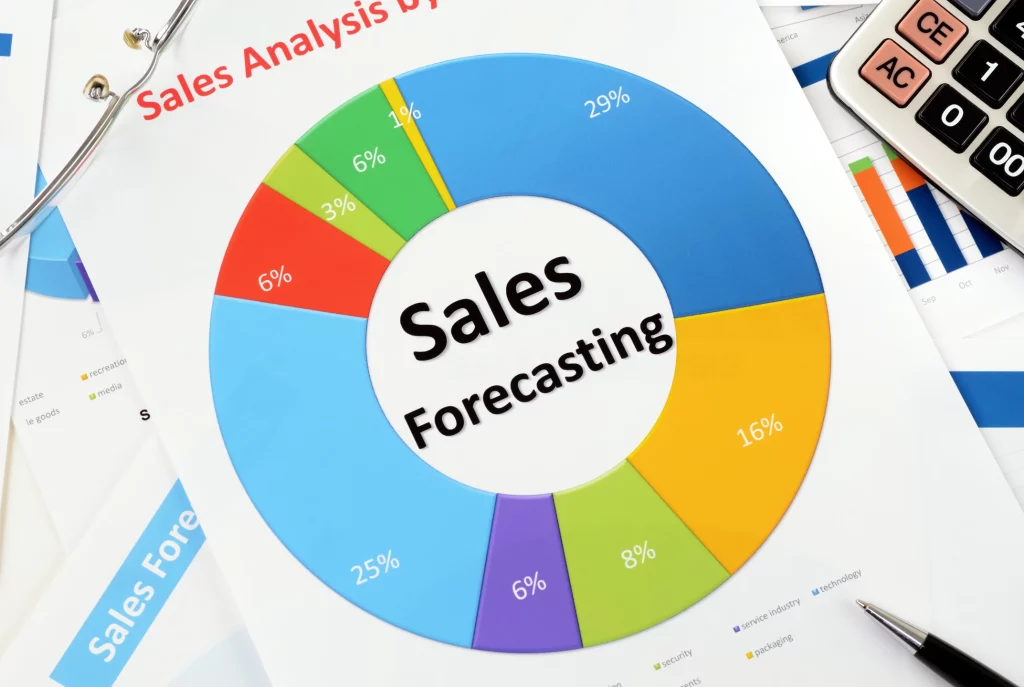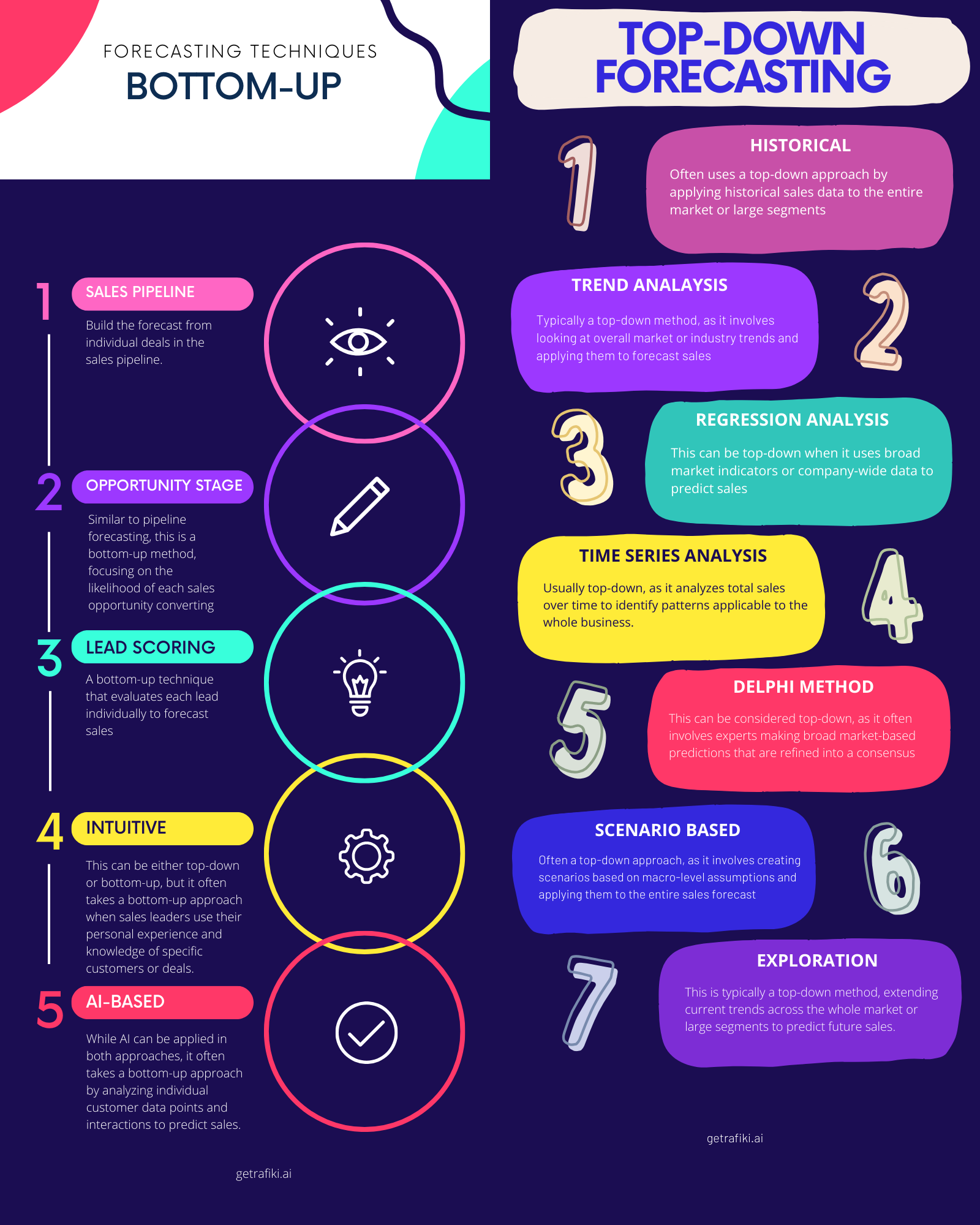Why Rafiki
Pricing


Pricing
Solutions

RevOps Leaders
Synchronize revenue generating functions

SDR Leaders
Get your team aligned and Coach your Reps 3x faster at scale

Sales Leaders
Unlock pipeline truth, drive confident forecasts

Imagine having a map that guides you through the unpredictable terrain of the sales world, a compass that points your business towards success and growth. This isn't the stuff of fantasy; it's the power of effective sales forecasting. In the high-stakes game of sales, the ability to foresee and navigate future trends isn't just an advantage—it's essential for survival and success.
As a sales leader, you're not just a strategist; you're a visionary. You need more than just numbers and data; you need insights that can transform raw information into a clear path forward. In this article, we're embarking on an exciting journey through the diverse landscape of sales forecasting techniques. From the time-tested methods rooted in historical data to the innovative frontiers of Generative AI and machine learning, these tools are your key to unlocking potential, mitigating risks, and capitalizing on opportunities. Whether you're a seasoned sales veteran or a rising star in the business world, mastering these techniques is your first step towards shaping the future of your enterprise.
Sales forecasting is the process of estimating future sales. It involves analyzing historical data, market trends, and economic conditions to predict sales revenues over a specific period. This process is both an art and a science, requiring a blend of data analysis, intuition, and experience. Sales forecasting can be conducted using various methods, ranging from simple extrapolation of past trends to sophisticated predictive modeling using artificial intelligence and machine learning.
At its core, sales forecasting is about making educated guesses. These guesses are based on patterns observed in past sales data, understanding of the current market, and assumptions about future market conditions. It’s not just about numbers; it’s about interpreting those numbers in the context of real-world events, such as changes in consumer behavior, economic shifts, and competitive dynamics.
The Role of Sales Forecasting in Business Planning and Growth
The significance of sales forecasting extends far beyond mere prediction of revenue. It is a crucial element in strategic business planning, as it influences decision-making in multiple areas:
In essence, sales forecasting is not just a tool for predicting the future; it's a compass that guides a business through the complex landscape of market dynamics, helping it to navigate challenges and capitalize on opportunities for growth.
Sales forecasting techniques can generally be categorized into top-down and bottom-up approaches. This Ernst & Young article discusses the significance of financial modeling for startups, emphasizing the use of a combination of top-down and bottom-up forecasting methods. The top-down approach starts with a macro perspective, narrowing down to specific targets suitable for a company, while the bottom-up approach focuses on internal company-specific data, such as historic sales, and builds upon the company's capacity. This combination allows for a balanced and substantiated forecast, blending ambition with realistic assumptions.

In practice, many organizations use a combination of both approaches for a more comprehensive and accurate sales forecast. The top-down approach is useful for setting overall targets and understanding market dynamics, while the bottom-up approach is excellent for getting a detailed and realistic picture from the ground up.
Both top-down and bottom-up forecasting methods have their unique advantages and limitations. Understanding these can help sales leaders choose the most suitable approach for their specific needs
| Top-Down Forecasting | Bottom-Up Forecasting |
|---|---|
| Offers a macro-level view of the market, helping in understanding larger trends and industry dynamics. | More accurate for short-term forecasting, as it builds the forecast from individual sales activities and customer interactions. |
| Generally quicker to execute as it involves applying general trends or historical data to the whole market or large segments. | More responsive to changes in the sales environment, customer preferences, or specific market segments. |
| Ideal for setting overall sales targets and long-term planning. | Can be tailored to specific products, regions, or sales teams, providing a nuanced view. |
| Effective in simplifying forecasting in complex markets with a vast array of products or services. | Involves input from the sales team, leading to potentially more realistic forecasts and greater team accountability. |
| Top-Down Forecasting | Bottom-Up Forecasting |
|---|---|
| May not capture the nuances of individual sales activities or customer segments. | Requires more detailed data collection and analysis, making it a more labor-intensive process. |
| Can be less accurate, especially in rapidly changing markets or where company-specific factors significantly impact sales. | Might miss broader market trends or external factors that could impact sales. |
| Offers less flexibility to account for unique aspects of different sales regions or product lines. | Can be challenging to scale in large organizations with numerous products or services. |
| Heavily dependent on the availability and accuracy of market data and trends, which might not always be up-to-date or relevant. | Heavily dependent on the quality of internal sales data and the effectiveness of the sales team's reporting. |
Lets take a deeper look at each of the above mentioned techniques
Historical forecasting involves using past sales data to predict future sales. It assumes that future trends will be similar to past trends. This method is straightforward and often used as a baseline for more complex forecasting methods.
Trend analysis involves examining past sales data to identify patterns or trends that are likely to continue into the future. It's used to predict long-term performance by understanding seasonal patterns, market movements, and other historical trends.
This method estimates future sales based on the number of deals in different stages of the sales pipeline. It considers factors like the probability of closing each deal, the average deal size, and the sales cycle length. It’s beneficial for its real-time insight into potential sales and helps in resource allocation and sales strategy adjustments.
Opportunity stage forecasting assesses each deal's stage in the sales process. It assigns probabilities of closing to each stage, calculating the potential revenue based on these probabilities. This technique is important for understanding which deals are more likely to close and prioritizing sales efforts.
Lead scoring involves assigning scores to leads based on their perceived value and likelihood of conversion. This method helps prioritize leads, focusing on those most likely to convert into sales. It's implemented by analyzing lead characteristics like engagement level, demographic information, and behavioral data.
Regression analysis is a statistical method used to identify relationships between variables (like sales and marketing spend) and predict future sales. It's useful for understanding how different factors influence sales and for making data-driven predictions.
Time series analysis looks at sales data over time to identify patterns, like seasonality or cyclical trends. It's beneficial for forecasting in stable markets where past patterns are likely to continue.
The Delphi method involves gathering and synthesizing opinions from experts to make forecasts. It's an iterative process where experts revise their forecasts based on the group's feedback. This method is effective for incorporating expert insights and achieving a consensus forecast.
Intuitive forecasting relies on the judgment and experience of sales leaders. It's used when data is limited or the market is too volatile for data-driven methods. It’s applicable in new markets or for new products where historical data isn’t available.
This method uses advanced algorithms to analyze large datasets and uncover complex patterns. AI-based forecasting is increasingly important due to its ability to handle vast amounts of data and provide highly accurate predictions. It's particularly useful for dynamic markets with numerous influencing factors.
Scenario forecasting involves creating different sales scenarios (like best case, worst case, and most likely case) based on various assumptions. It helps in planning for different potential futures and is useful for risk management and strategic planning.
Extrapolation is a simple forecasting method where current trends are extended into the future to predict outcomes. It's based on the principle that the conditions causing the current trend will continue. This method is useful for short-term forecasting in stable markets.
Each of these techniques has its unique strengths and is suited for different situations. Sales leaders often use a combination of these methods to develop a more comprehensive and accurate forecast.
When choosing a sales forecasting method, several key factors should be considered to ensure the chosen method aligns with the specific needs and context of the business. These factors include:
Aligning the chosen sales forecasting techniques with business objectives is crucial for several reasons:
Selecting the right forecasting method depends on a thorough understanding of various internal and external factors. Aligning this method with the overall business objectives ensures that the forecasts are not only accurate but also actionable and relevant to the strategic goals of the organization.
The advent of technology, particularly Artificial Intelligence (AI) and Generative AI have significantly transformed the landscape of sales forecasting. These technological advancements have introduced new capabilities and efficiencies, revolutionizing how sales data is analyzed and predictions are made. Tools like Rafiki help sales leaders understand and navigate this complex arena
AI in Sales Forecasting
Examples of Tools and Software for Sales Forecasting
Several tools and software solutions have emerged, leveraging AI and ML to assist in sales forecasting:
These technologies are not just facilitating more precise predictions; they are reshaping the entire approach to sales strategy and decision-making.
Furthermore, EY's insights into integrated supply chain planning shed light on the need for comprehensive and cohesive planning strategies. This involves not only technological advancements but also a focus on people and processes, ensuring collaboration across various functions within an organization. Such an approach is becoming increasingly essential in managing the complexities and disruptions in today's supply chains.
Here are some tips and strategies to improve the accuracy and effectiveness of sales forecasts:
It is also important to continuously evaluation and adjust forecasting methods to
The accuracy and effectiveness of sales forecasts hinge on the ability to leverage data intelligently, integrate technology, and stay adaptable to changes. Continuous evaluation and adjustment of forecasting methods are critical in maintaining their relevance and effectiveness in a rapidly changing business environment.
In summary, mastering sales forecasting is essential for today’s business leaders. The techniques we've explored, from traditional methods to advanced AI-driven approaches, offer diverse tools for navigating sales challenges. Choosing the right method depends on your business context and goals, and it's crucial to adapt and update these methods regularly to stay aligned with market dynamics. Effective sales forecasting is not just about predicting the future; it's about strategically preparing for it. Embrace these techniques to guide your business towards growth and success in an ever-changing marketplace.